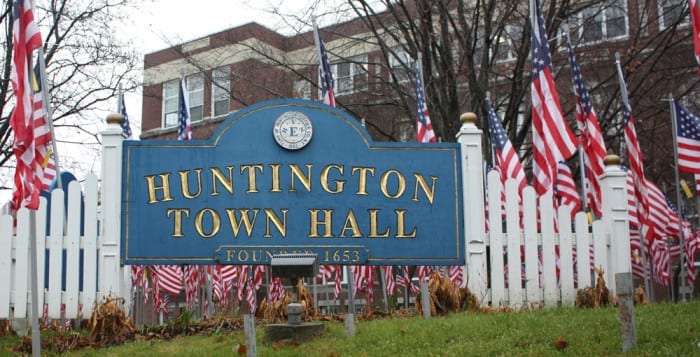Town of Smithtown officials have taken steps to approve roughly $4.5 million in investments in its parks, but residents are questioning which ones are given top priority.
Smithtown approved a $174,500 contract to redesign Flynn Memorial Park into a modern sports complex while greenlighting plans to construct a new playground and spray park at Callahans Beach at its July 17 meeting. The total price tag for those two projects is estimated at $4.5 million.
“We are doing a lot of work that needs to be done at the parks and beaches at a huge financial cost,” Councilman Tom Lohmann (R) said. “It won’t be done in one year, it has to be done smartly. But, it has to be done.”

At Callahans Beach, town officials have proposed a plan to rip up a portion of the asphalt parking lot in order to install a new playground at an estimated cost of $175,000, a spray park for roughly $150,000 and to construct picnic area shelter for approximately $200,000. Lohmann, who serves as the board’s liaison to the town Department of Parks, Buildings & Grounds, said the improvements are a result of the town’s approved lease agreement with Propagation Solutions Inc., for Site Tech Wireless LLC to install a 150-foot cell tower in the upper parking lot.
“As part of their recommendations and requirements for the cell tower, we had to make changes to Callahans Beach,” the councilman said. “We will be adding the playground and some beautification to ensure it is still aesthetically pleasing.”
Lohmann said the town hired St. James-based RDA Landscape Architecture to create a plan for the Kings Park’s Flynn Memorial Park project. One of the first steps is $2.2 million for all new LED lighting for the fields along with new field layout, new fencing as well as a new concession stand in the center of the park that will also contain bathrooms. The proposed plans call to tear out the existing facilities, install a new playground, repave the parking lot and redesign the layout to reduce it to one main entrance.
“By making it a true softball-baseball complex with a playground for kids to come play on, we hope it will help drive people into our communities,” Lohmann said. “It will be done and upgraded to where it should have been many years ago.”
The latest announcement of capital improvements to Smithtown’s parks comes shortly after the town celebrated the grand reopening of three parks after $1.3 million in refurbishments: Joseph Andreoli Park in Nesconset and Gaynor Park and Veterans Memorial Park in St. James.
Smithtown residents have questioned how elected officials are deciding which parks take priority in receiving upgrades.

Michael Vizzini, a four-year homeowner on Stanwich Road, said he hopes there will be some consideration given to Morewood Park. The park consists of two basketball courts whose surfaces have a spiderwebbing of cracks stretching across it, with the back boards showing signs of rust. The playground fell victim to a fire more than 10 years ago, according to the town parks
department, and was rebuilt on a soft wood mulch base with metal slides, a set of swings and dotted with a few spring-based animals on which to ride.
Vizzini, who lives adjacent to the park’s back entrance, has been looking for a way to improve its aesthetics since he moved in.
“I’ve called the town to see if they will remove the partial sidewalks so I can plant bushes there next to my white picket fence,” he said. “Contractors won’t touch it, it’s town property.”
Vizzini said he purchased on Stanwich Road to be close to the park for his two young children, but unfortunately, there isn’t much there on which they can safely play.
Commack resident Bridget Zaminer, a Knolls Lane homeowner, said she’s lived in the area for three years and has only taken her three young children to Morewood Park a handful of times to use the basketball courts.

“The play equipment is old and dingy,” Zaminer said in an email. “Not to mention, I would not want to be there alone since it’s so desolate.”
Lohman said the town’s parks department did a full review in 2017, which estimated the town would need $11.6 million to bring all its parks and beaches up to date.
“Where do you get $11.6 million?” he asked. “Monies weren’t properly put back into the property to keep these facilities and assets up to standard.”
The councilman said factors used to determine which sites will get funding include estimated community use, safety concerns and consideration for those facilities where the town provides additional services for which a fee is paid — such as boat slips at the marina or sports fields utilized by adult leagues. He admitted dozens of town “pocket parks,” or recreational areas surrounded by residential properties like Morewood, are in desperate need of updates so it’s a tough call.
Lohmann said he has a meeting with Supervisor Ed Wehrheim (R) and parks director Joseph Arico scheduled for Aug. 2 to discuss the town’s 2019 capital budget and which parks to update. Residents should be pleased to know sites being given consideration include the town’s marina and Morewood Park.
“[Morewood] doesn’t get a tremendous amount of use,” Lohmann conceded. “But with younger and younger families moving into the neighborhood, it’s getting attention.”

















